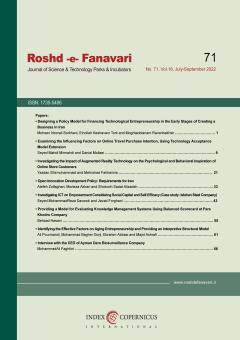-
-
List of Articles
-
Open Access Article
1 - Designing a policy model for financing technological entrepreneurship in the early stages of creating a business in Iran
Mohsen Noorali Sorkhani eynollah keshavarz tork Moqtadaalanam Ravanbakhsh, -
Open Access Article
2 - Examining the Influencing Factors on Online Travel Purchase Intention, Using Technology Acceptance Model Extension
seyed mehdi mirmehdi Danial Molaei -
Open Access Article
3 - Investigating the Impact of Augmented Reality Technology on the Psychological and Behavioral Inspiration of Online Store Customers
Yazdan shirmohammadi Mehrshad Fakharinia -
Open Access Article
4 - Open Innovation Development Policy: Requirements for Iran
atefeh zolfaghari Morteza Akbari Shokooh Sadat Alizadeh -
Open Access Article
5 - Investigating ICT on Empowerment Considering Social Capital and Self-Efficacy (Case study: Isfahan Steel Company)
sayyed mohammad reza davoodi javad gharaghani -
Open Access Article
6 - Providing a Model for Evaluating Knowledge Management Systems Using Balanced Scorecard at Pars Khodro Company
Behzad Hasani ٌRocxana Fekri -
Open Access Article
7 - Identifying the effective factors on aging entrepreneurship and providing an interpretive structural model
ali poormandi Mohammad Bagher Gorji Ibrahim Abbasi majid ashrafi
-
The rights to this website are owned by the Raimag Press Management System.
Copyright © 2017-2025







